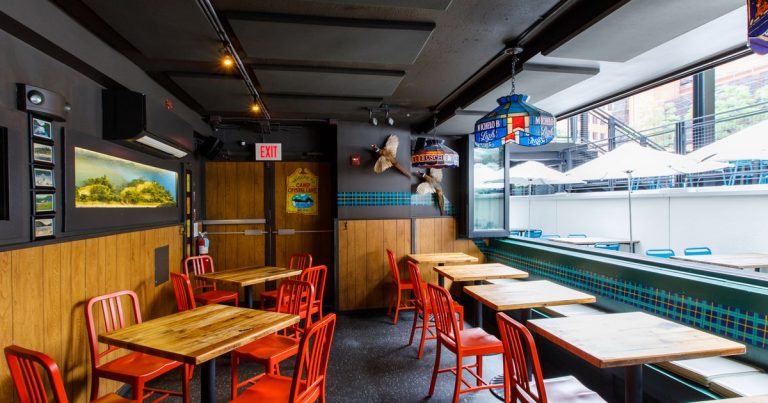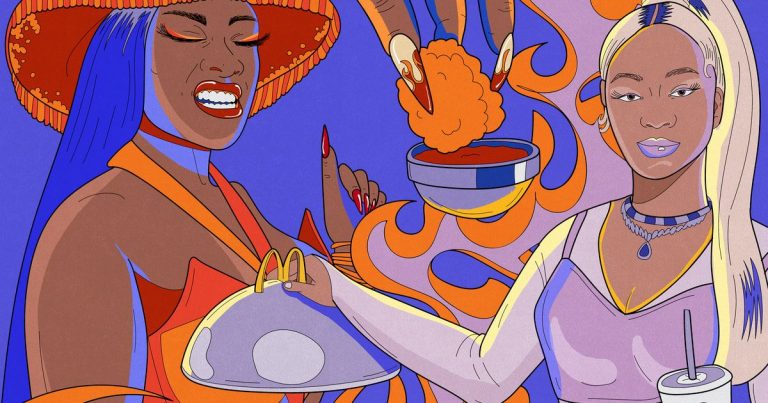How the Rise of the Starbucks Unions Could Be Groundbreaking for the Food Industry
Across the country, Starbucks has seen growing momentum for unionization. After a year-plus of organizing, workers at more than 140 Starbucks locations have announced plans to unionize as Starbucks Workers United, and at least six of those stores have won their union campaigns, demanding higher wages, better health insurance, and better safety protocols during the pandemic. “Workers’ rights here in Knoxville have prevailed,” said Knoxville barista and organizing committee member Maggie Carter after the vote. “We are carving our path to a successful partnership with this company that we truly adore, and it’s taken a lot of patience and perseverance to get to this moment.”
The union wave that is sweeping the hospitality industry isn’t limited to Starbucks. Workers at Oregon burger chain Burgerville ratified the first union contract in the fast-food industry in December 2021, and similar campaigns have occurred at chains like Voodoo Doughnut and Colectivo Coffee. But Starbucks in particular has often acted as a bellwether in the restaurant industry, for better and worse, under the guise of corporate progressivism. It brought “the third place” into our everyday consciousness, which made working on your laptop from a coffee shop nearly as normal as sitting in an office, and it’s credited with making brand-loyalty apps and online mobile ordering a thing across quick-service restaurants. It was among the national chains that normalized mask mandates at the onset of the pandemic in lieu of actual guidance from the government. On the local, neighborhood level, the arrival of Starbucks is considered a universal sign of impending gentrification. Put simply: As Starbucks goes, so goes the industry.
Right now, all eyes are on Starbucks, because what’s happening there offers some major insight into the future of the American labor movement. Starbucks is one of the restaurant industry’s largest employers, with more than 350,000 workers on its payroll across 9,000 stores, more than 140 of which have announced union campaigns. But the rapid momentum building is a glimpse into what it might look like for unionization to find success in an industry that could desperately use more workplace protections. Despite organizing in a variety of sectors, the labor movement has been stagnant for decades. According to the U.S. Bureau of Labor Statistics, union membership hit an all-time low in 2021, with just 10.5 percent of American workers belonging to unions. This decline in union membership has been associated with both wage inequality and wage stagnation, issues that became abundantly clear during the COVID-19 pandemic.
Workers have been attempting to organize unions at Starbucks since the 1980s, but those efforts were largely considered failures until 2021, when baristas in Buffalo, New York, won their first union election. According to Andrew Ross, professor of social and cultural analysis at New York University, that success has a lot to do with timing. The pandemic provided an opportunity for workers in the restaurant industry — Starbucks included — to really contemplate their working conditions. Unions, which promise benefits like yearly wage increases and contractually negotiated safety protocols, seemed especially appealing. “The pandemic put a lot of pressure on in-person service workers, and the conditions made them think more intensively about the jobs that they do,” Ross says. “They realized, ‘Wow, I’m an essential worker, and essential workers should have essential rights.’”
Starbucks is, arguably, the most obvious entry point for unionization in the hospitality industry. Starbucks workers are younger on average than other hospitality employees, and young people tend to be more engaged in unionizing efforts than their older counterparts. We are living in the era of the “over-educated” barista, in which a higher percentage of Starbucks’s workforce is college-educated than most hospitality industry employers’, thanks in part to the company’s free tuition program. (Notably, that program is now eclipsed by those offered by other major employers like Amazon and Target, which had originally followed Starbucks’s lead.) “It’s a diverse workforce, the workers are young, and a lot of them are quite highly educated. They’re the classic liberal arts majors,” says Susan Schurman, distinguished professor at Rutgers University’s School of Management and Labor Relations. “Another lesson from the history of labor in the United States is that surges in union organizing have tended to be led by highly skilled workers.”
The company also has a lower turnover rate than many food-service businesses, and its locations are operated by Starbucks, which means that the union has only one employer to negotiate with as opposed to a maze of franchisees, which has stymied efforts to improve working conditions at chains like McDonald’s.
Starbucks has fought the union effort every step of the way, and part of the company’s anti-union argument is that the working conditions at the country’s largest coffee chain are so good that workers simply do not need a union. And it’s true, Starbucks is a better place to work than many other major hospitality industry employers — it offers a $15 minimum wage, nearly double the federal minimum wage, plus paid time off and parental leave for some workers. As with the company’s paid college program, other employers are taking notice and now offering benefits — and wages — that eclipse those offered by Starbucks.
But as union organizers have long noted, companies that unilaterally offer decent benefits can also unilaterally rescind them, and workers at Starbucks want to ensure that the company has an obligation to follow through with its public posturing as a progressive employer. “Starbucks is one of the better companies out there, and even companies that are great can treat workers pretty terribly,” Sam Amato, a barista at a union Starbucks in Amherst, New York, told Eater in December. “I would like to see more people realize that they have the power to do something that could change their workplace.”
Starbucks Workers United is also benefiting from a political climate that’s more friendly to workers than in years past. President Joe Biden’s appointment of more labor-friendly bureaucrats to the National Labor Relations Board, the federal agency that protects the rights of organizing workers, will likely prove to be a boon to these efforts. During the Trump presidency, the NLRB engaged in “unprecedented” attacks on workers’ rights, and it seems unlikely that these organizing campaigns would’ve been as successful just three years ago. “When you have a Board that’s more sympathetic to worker rights, then it can operate quite efficiently and rapidly,” Ross says.
With a friendlier National Labor Relations Board at their backs, union organizers are pursuing wage increases and better health insurance benefits in the contracts that they will eventually negotiate with Starbucks. If they are able to secure those gains, it’s likely that these organizers will be able to boost wages and working conditions at hospitality businesses that have not yet even unionized. And wins at Starbucks locations across the country can inspire other workers to unionize their workplaces, even in places where unions have not traditionally found success in organizing workers. “The history of labor in the United States is essentially long periods of what looks like nothing, even defeat,” says Schurman. “And then something in the larger context changes, like the pandemic, and stimulates worker interest in collective action.”
Starbucks workers still have a lot of hurdles to cross. Starbucks has openly stated that it will take an offensive approach toward the union efforts instead of sitting down to negotiate directly with workers. “Because of U.S. labor law, there are all kinds of ways that employers can basically refuse to bargain,” Schurman says. “Even if you’ve won a certification vote, it’s possible that many of these stores could never get to a contract. During that time, the company can hope that people get discouraged, maybe some quit. Maybe they’ll fire a couple people that are leaders, even though it’s an unfair labor practice. And even though they’ll have to pay them back wages, their ‘union avoidance’ consultants will tell them it’s just the cost of doing business.”
Last year, the NLRB found that Starbucks had illegally retaliated against union organizers at a Philadelphia location by firing them “in an attempt to quell the union drive.” The agency ordered Starbucks to stop interfering with union organizers, and required that the company post a notice to all employees informing them of their rights to organize, along with compelling the company to reinstate the employees that it had fired and repay any compensation that they lost. The agency has also rejected multiple requests from Starbucks to require baristas in a specific city, like Buffalo, to organize unions across the entire city as opposed to organizing their individual stores, and there are currently more than 70 unfair labor practice charges filed against Starbucks that are still pending.
It’s an even taller order for workers in the hospitality industry more broadly. The industry is notorious for its high turnover rates, and high turnover makes it more difficult for union campaigns to succeed. But there are still plenty of reasons to be optimistic about the future of unions at Starbucks, and the impact that they’ll have on workers in the hospitality industry. Workers are winning the right to bargain collectively in even union-hostile states, like Arizona, where right-to-work laws make it difficult for unions to sustain themselves financially and weaken their bargaining power. Two locations in Mesa have already voted to unionize, despite allegations of union-busting and retaliation from Starbucks, and elections are currently in the works in Oklahoma, Tennessee, and Texas. “Mesa, Arizona is not a union town, so I think winning there really shows others, in a very positive way, that even if you’re in a right-to-work state, and even though you’re working in a very small shop, you could still pull it off,” Ross says.
At this point, it’s too early to tell whether or not the efforts to unionize Starbucks will be successful, but as Schurman notes, “nothing succeeds like success.” “I predict that, although it may take some time, these unions are going to win these campaigns,” she says. “They’re going to win because organized labor is going to demand it.”






